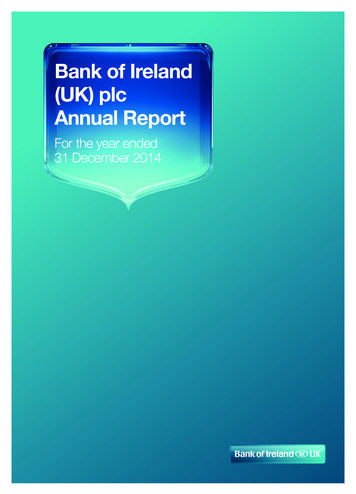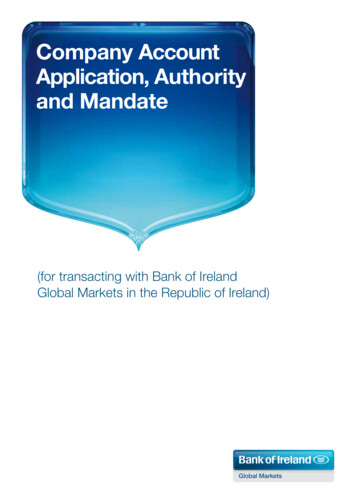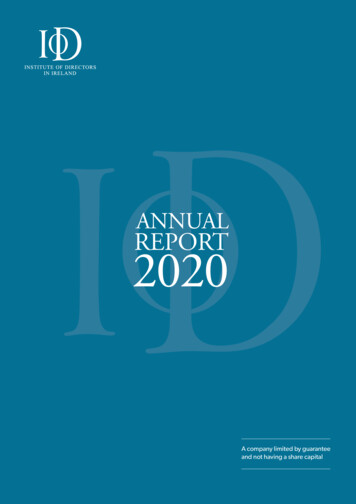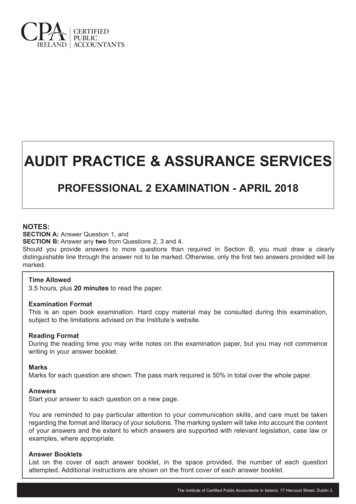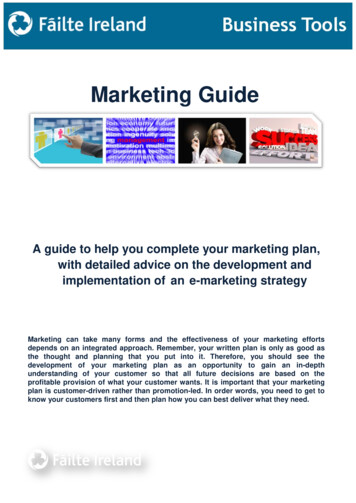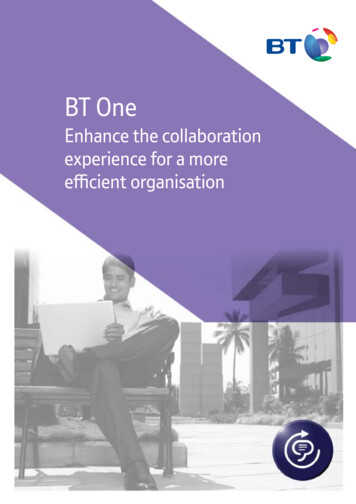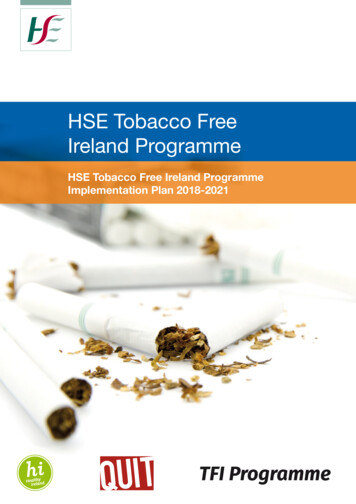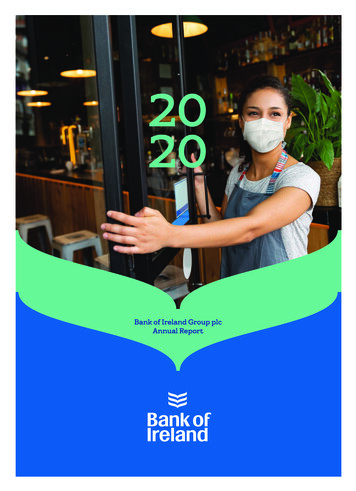
Transcription
HoldCo Annual Report 2020 - Front.qxp Layout 1 27/02/2021 03:18 Page 12020Bank of Ireland Group plcAnnual Report
HoldCo Annual Report 2020 - Front.qxp Layout 1 27/02/2021 03:18 Page 2Bank of Ireland Annual Report 2020‘2020 was an exceptional year with a myriad of challengesfor people, communities where we operate, and for allbusinesses, including banks. At Bank of Ireland, from thestart of the COVID-19 crisis, we quickly focused ourresources and efforts on protecting and supporting ourcustomers, colleagues and communities. The investmentwe’ve made in recent years in transforming our culture,systems and business model underpinned our ability toquickly adapt to the impacts of COVID-19.’Francesca McDonaghGroup Chief ExecutiveInside this reportStrategic Report3Chairman’s review4Chief Executive’s review8Our Ambition, Purpose and Values12Our strategy13Responsible and Sustainable Businessat Bank of Ireland20Governance in action42Risk review45Financial ReviewGovernance4771Risk Management Report134Financial Statements190Other Information342View this report onlineThis Annual Report and other information relating toBank of Ireland is available at: www.bankofireland.com232020 key performance highlightsThe Group's forward looking statementcan be found on page 372.
HoldCo Annual Report 2020 - Front.qxp Layout 1 27/02/2021 03:18 Page 3Strategic ReportFinancial ReviewGovernanceRisk Management ReportFinancial StatementsOther InformationBank of Ireland Annual Report 2020Strategic Report2020 key performance highlights 760mLoss before taxFinancialPerformance Underlying1 lossbefore tax 374m(2019: 645mprofit)(2019: 758mprofit)Return to profitabilityin H2 2020.Net interest margin of 2.00% (2019: 2.14%).6th straight reporting period of reductions; costs reduced byfurther 4% vs. 2019.Irish mortgage market; share increased 2% to 25.5% in 2020.Total operating income2 reduced by 8% versus 2019; lowerbusiness income and valuation item movements. 4%/ 65m 67%employeeengagement score(increase of 5% sinceQ4 2019)c. 10minvested in learningand development forcolleagues1234(2019: 4%/ 67m)Achieved 2021 cost target ofc. 1.7bn4 one year early.New cost target of 1.5bn by 2023.Further progress in the UK; Northern Irelandstrategic review complete.Digital progress supports new branch strategy;c.33% of branches to close RegulatoryCET1 ratio10k 2bnsecondary school pupilsavailed of 'MoneySmarts', a free financialeducation programme 77%male / femaleappointments tomanagement andleadership positionsCapital 59:41 1.1bnNet credit impairment charge of(2019: 215m) 1.1bn (2019: 0.2bn), of whichc.60% relates to performing loans.NPE ratio increased from 4.4% in 2019to 5.7%; stable in H2.Payment break outcomes more positive thanexpected; 94% expired and only c.4% have migratedinto new arrears status3.Reduction inunderlying set Quality14.9%(2019: 15.0%)Fully loadedCET1 ratio13.4%Strong capital position;(2019: 13.8%)regulatory CET1 ratio 14.9%and c.510bps headroom to minimumregulatory requirements; fully loadedCET1 ratio 13.4%Pre-impairment organic capital generation of 80bpsin H2 vs 45bps in H1Successfully completed two Additional Tier 1 (AT1)transactions, totalling 975 million.reduction in carbonemissions intensity (on2011 baseline)Sustainable FinanceFund and first bank inIreland to introduce agreen mortgageFurther information on financial measuresreferred to in our 2020 key performancehighlights is found in Alternative performancemeasures on page 373.The Group’s financial results are presented on an underlying basis. Underlying excludes non-core items which are those items of 386 million that the Group believes obscure the underlyingperformance trends in the business. For further details on the Group's non-core items see page 52.Operating income net of insurance claims.Balances now categorised as arrears not in arrears prior to payment breaks; as at 12 February 2021.Underlying costs include core transformation investment charges, exclude non-core items of 424 million, levies and regulatory charges of 125 million and impairment of intangibleassets and goodwill of 12 million. Including these items total costs were 216 million or 10% higher than 2019. The calculation of which is set out on page 379.3
HoldCo Annual Report 2020 - Front.qxp Layout 1 27/02/2021 03:18 Page 4Bank of Ireland Annual Report 2020Chairman’s reviewOur purpose, to enable our customers, colleagues andcommunities to thrive, was a clear North Star for theGroup in responding to COVID-19. The banking systemsupported the economy during the pandemic, and willcontinue to be a key player in the recovery.In Great Britain, we will have a morefocused, smaller, but more profitablebusiness. In Northern Ireland, we willoptimise our physical footprint while alsoinvesting in technology to support ourbusiness. We will also relocate our UKHeadquarters from London to Belfast,reinforcing our commitment to NorthernIreland, where Bank of Ireland has had apresence since 1825.Patrick Kennedy ChairmanIntroductionThe impact of COVID-19 on our society hasbeen unprecedented. On behalf of theBoard of Bank of Ireland, I would like toextend our sympathies to all who havebeen affected by the pandemic. I wouldalso like to thank Francesca and herleadership team, and all of our colleaguesacross the Group, for their ongoingcommitment to our customers over auniquely challenging year.A path to post-COVID-19 normality is nowbecomingvisible;however,theconsequences of the pandemic willendure for some considerable time for usall, including for Bank of Ireland. Otherexternal challenges include the interestrateenvironment,andcontinueduncertainties relating to the UK’s decisionto leave the European Union.That said, as the leading lender to thefastest-growing economy in Europe last14year, the Group benefits from an extensivecustomer base and franchise in a countrywith one of the youngest, fastest-growingpopulations in the developed world.StrategyGood progress was made in 2020 onadvancing the Group’s strategy. Wemaintained strong momentum on our keyprioritiesandacceleratedcertaininitiatives in response to r customers availed of a wide range ofnew digital enhancements during the year.We hit our 2018 Investor Day target toreduce our cost1 base to c. 1.7 billion oneyear early and we now target reducing ourcost base to 1.5 billion by 2023. Wecontinued to progress our strategicpriority to improve returns in our UKbusiness.Customer preferences continue to evolve,and our significant transformationinvestment over recent years hasimproved our technology infrastructure,digital offering and customer engagement.At the same time, we have seen asustained decline in the use of ourbranches. Our customers tell us that theyexpect visits to branches to reduce furtheras they move away from cash towardsdigital and contactless payments. We areadapting to these clear changes inbehaviour as we work towards a longterm, sustainable and modern bankingsystem.Accordingly, following an extensive reviewof our network, we have taken thedecision to close 103 branches in theRepublic of Ireland and Northern Ireland.We will continue to operate 182 branchesacross the island of Ireland. The brancheswill be an integral part of the Group’sstrategy of blending physical and digitalservices to meet our customers' evolvingneeds.Capital and RegulationThe resilience of the Bank's businessmodel and balance sheet was wellevidenced in 2020. Despite theunprecedented impact of the pandemic,the Group ended the year with a strongcapital position. This is after taking aprudent and comprehensive view of theThe Group’s financial results are presented on an underlying basis. Underlying excludes non-core items which are those items that the Group believes obscure the underlyingperformance trends in the business.
HoldCo Annual Report 2020 - Front.qxp Layout 1 27/02/2021 03:18 Page 5Strategic ReportFinancial ReviewGovernanceRisk Management ReportFinancial StatementsChairman’s review (continued)Other InformationBank of Ireland Annual Report 2020RelatedpagesCEO review (page 8)Responsible & sustainablebusiness (page 20)Risk management (page 34)impact of COVID-19 on our loan book, aswell as continuing to invest in the Group’stransformation.We also benefitted from relief provided byour regulators as they acceleratedimplementation of measures whichresulted in lowering risk weightings for ourSME loan book, and changing the capitaltreatment of our software assets. This wasone of a number of supportive regulatorychanges following the onset of thepandemic. Countercyclical buffers wereset to zero in Ireland and the UK; the ECBalso announced an acceleration ofchanges to the composition of banks’ Pillar2 Requirements; and the introduction of aSystemic Risk Buffer in Ireland wasdeferred. Collectively, these measureshave bolstered the strong headroom theGroup has over its minimum regulatorycapital requirements, and we acknowledgethe regulators' supportive actions.In relation to capital requirements, webelieve it important for institutions to beable to plan over a medium-to-long termcycle. We encourage as much visibility andstability as possible from our regulators onthis matter, as is the case in many otherregulated sectors. This is important forpotential future providers of capital to thesector.RemunerationCertain participants in the Irish bankingsectorremainatacompetitivedisadvantage due to the remunerationrestrictions that apply. These restrictionsare far reaching, and prohibit the Groupfrom approaching remuneration in asimilar way to other corporates – bothbanking and non-banking – with whom wecompete for talent. Meanwhile, thesubstantial increase in the presence ofinternational financial services firms inIreland has led to greater intensity incompetition for talent in a variety of areas,including key prudential functions. Therestrictions are a concern for investors, asthey seek assurance that the Group canattract and retain talent and thatmanagement is appropriately incentivisedto deliver sustainable returns.The Irish banking system receivedextraordinary support during the financialcrisis of a decade ago, for which we remainvery grateful. Bank of Ireland is uniqueamongst Irish banks in being the onlyinstitution to have fully repaid the Irishtaxpayer, which we did in 2013; the Stateis now showing a sizeable profit on itsinvestment in the Group. Having repaidthe taxpayer in full, Bank of Ireland’s viewis that it should now be permitted todevelop a more normalised remunerationapproach, aligned to European BankingAuthority Guidelines, which have beensignificantly extended to be much stricterthan what operated in the past, with amuch clearer emphasis on riskmanagement and sustainability.Purpose and CultureOur purpose, to enable our customers,colleagues and communities to thrive, wasa clear North Star for the Group inresponding to COVID-19. The bankingsystem supported the economy during thepandemic, and will continue to be a keyplayer in the recovery.To achieve our purpose, an appropriatecorporate culture must be embeddedacross the organisation. We have adaptedour culture very significantly over the lastthree years, and there has been furtherimprovement in 2020 in our engagementand cultural embedding scores, assessedthrough staff surveys with very highparticipation rates. In cultural embedding,Bank of Ireland’s score surpassed theglobal average for financial services for thefirst time in 2020.Crises provide a true test of anorganisation's culture; under pressure, werevert to our default behaviours. Thespeed, agility and customer focus withwhich colleagues responded to COVID-19provided real-life evidence of the changesin Bank of Ireland in recent years.Responsible and Sustainable BusinessAn effective and transparent Responsibleand Sustainable Business (RSB) strategy isa fundamental expectation of allstakeholders,includinginvestors,customers and colleagues. The Group fullyendorses this expectation.Following its commitment to the UNPrinciples for Responsible Banking in2019, the Group has made good progresson its RSB agenda during 2020. Amongstother things, we undertook an exercise tounderstand the impact the Group’sproducts and services have on theenvironment and society and we engagedwith a broad range of stakeholders tounderstand their priorities. This hasinformed the development of our new RSBstrategy, overseen by the Board’sNominations,GovernanceandResponsible Business Committee. Our RSBstrategy is detailed from page 20 and setsout the Group's overarching approach tothis critical area.BoardAs COVID-19 became a reality in earlyMarch, the Board moved to holding twomeetings every week; this heightened levelof engagement continued for a number ofmonths. In total, the Board met 31 timesduring the year, and 84 times including allCommittee meetings.The Board’s initial focus was on ensuringthe health and safety of our colleaguesand customers, the continuity of Groupoperations, and the availability andreliability of service to our customers. TheBoard also dedicated significant time to: our strategy, including how COVID-19would impact it; supports required by customers facingfinancial distress as a consequence ofthe pandemic; the potential financial and capitalimpact of COVID-19 on the Group; the role of the Group and the bankingindustry generally in supporting theIrish economy.There were a number of changes to theBoard in 2020. Patrick Haren and PatrickMulvihill retired at the end of the year,having each served nine years. They bothmade significant contributions to theGroup, bringing experience, insight, rigourand exceptional commitment to theirroles, and leave with our gratitude andvery best wishes. Patrick Haren wassucceeded as Deputy Chairman andSenior Independent Director by RichardGoulding, who has served as anindependent Non-Executive Director since2017. Patrick Mulvihill was succeeded asChair of the Gro
Bank of Ireland Annual Report 2020 Patrick Kennedy Chairman 4 1 The Group’s financial results are presented on an underlying basis. Underlying excludes non-core items which are those items that the Group believes obscure the underlying performance trends in the business. HoldCo Annual Report 2020 - Front.qxp_Layout 1 27/02/2021 03:18 Page 4 . impact of COVID-19 on our loan book, as well as .
